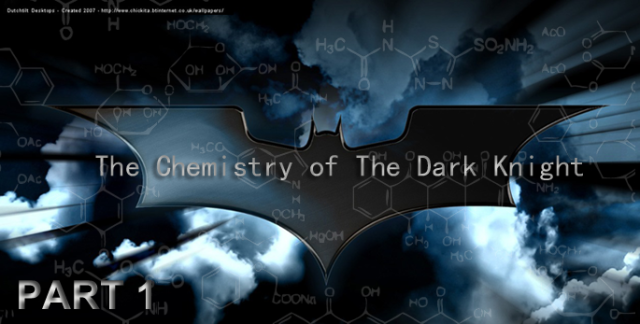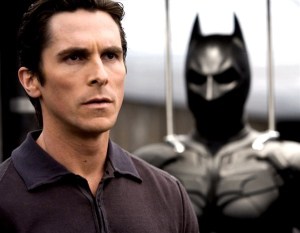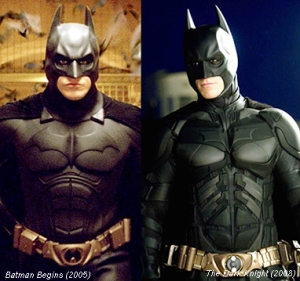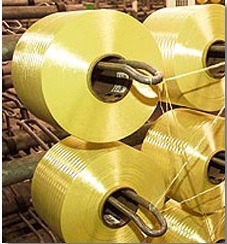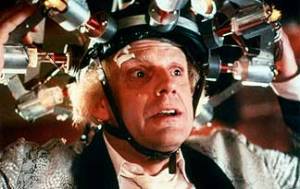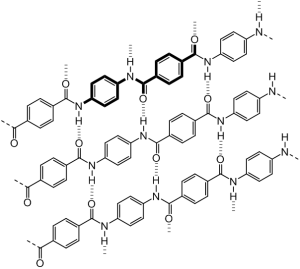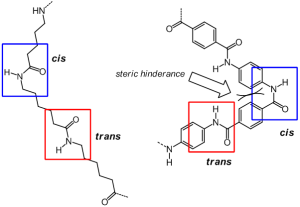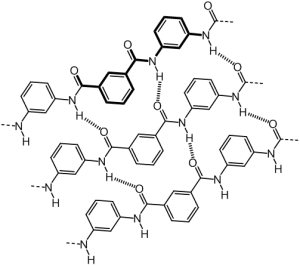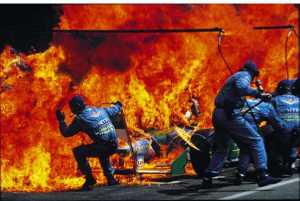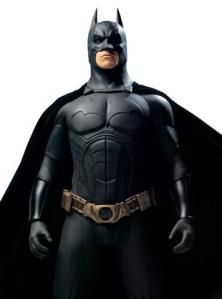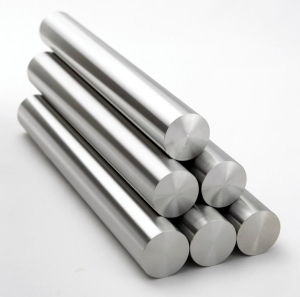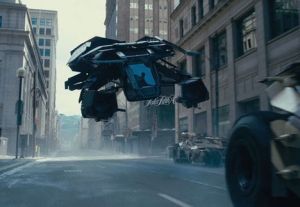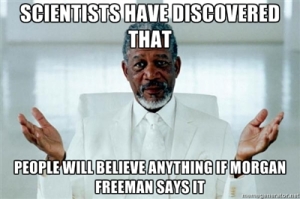The Chemistry of the Dark Knight (Part 2)
Disclaimer: Obviously, I don’t own BatmanTM or any of the other stuff discussed in this blog post. This is just for fun, so Warner Brothers and DC, please don’t sue. The same goes for all the owners of any trademarked compounds mentioned or any other intellectual property, especially you George.
Second disclaimer: Many of the compound mentioned in this blog post are extremely dangerous. I do not endorse the use of any of this stuff. Batman is a fictional crime fighter, so don’t go getting any ideas.

From this point onwards, there be potential spoilers for The Dark Knight trilogy. You’ve been warned.
Welcome to the second part of my look at some of the chemistry at work in the adventures of the intrepid Dark Knight. In the previous part, I got somewhat wrapped up in the materials used to make the Batsuit. This time I’ll be focusing on his gadgets (and a few other bits and bobs I just randomly threw in).
“I’m Batman”
Just imagine that line in a husky voice and if you’re the kind of geek I think you are then you’re probably getting tingles. He’s not the hero we need, but the hero we deserve…or something like that. He’s not a superpowered alien from across the cosmos, he’s just your average orphan-billionaire-genius-playboy turned crime-fighting vigilante. Without superpowers Batman relies on other things and Batman wouldn’t be Batman if he didn’t have his trusty utility belt, filled to the brim with all manner of useful gadgets to help him battle the scum of Gotham City.
So the question is:
“Where does he get What Chemistry is invovled in all of those wonderful toys…?”
I’ve generally been focusing on Christopher Nolan’s version of Batman, being that his is the most “gritty and realistic” (not to mention recent) version of the character on film thus far. Even though there have been some changes over the years, certain elements of Batman’s arsenal have stayed the same.
As such, some of the gadgets discussed below naturally overlap with other versions of the Batman and there are all kinds of wacky things that I could cover from the past, but that we don’t have time for.
On the plus side, there won’t be room to talk about any of the ridiculous “gadgets” in Batman & Robin; the less said about that film the better.
So let’s start with the basics….
Batarangs
Probably the single most iconic Batman gadget is fairly boring in Christopher Nolan’s universe (so we’ll skip right along). Having originally been more like their namesake, the boomerang, they’ve tended toward being more shuriken-like recently (which is more in keeping with Batman’s ninja like fighting style).
In other films, the batarang has been remote (Batman Returns) and sonar controlled (Batman Forever), whilst the comics and other interpretations of the character have included explosive, cryogenic and electrically charged variants.
So Nolan’s batarang is basically a modern shuriken, which are these days mostly made of lightweight stainless steel and are commercially available (apparently) in Europe and parts of America. I should point out that unless you are a trained ninja or…you know, Batman, you should leave those well alone.
Throughout the Dark Knight Trilogy, Batman has used Batarangs to smash windows, knock out lights or act as distraction; however despite being like shuriken we don’t actually see him use these for offensive purposes. Similar smaller projectiles are used against Bane’s henchmen in The Dark Knight Rises (more on those later), but a traditional batarang is never used for preventing criminals escaping (this makes me a little sad inside).
So is there chemistry involved in them? …A little.

A blog post of mine wouldn’t be complete without a picture of some generic metal rods would it? If you didn’t come up with a joke about rods the first time, nows your chance.
Stainless steel is quite a well known alloy of iron, carbon and chromium (where chromium content is greater than 10.5%). It gets the name “stainless” because unlike normal steel it rusts far less being much more resistant to oxidation (i.e. the formation of iron oxide) and corrosion.
I said chromium…Not chrome. Blooming Google taking over the world….
Anyway….so why include chromium (symbol Cr, Atomic number 24)? Well, when exposed to oxygen in the air, chromium very rapidly reacts to form a layer of chromium (III) oxide (Cr2O3) upon its surface. The layer is invisible to the human eye, being only several atoms thick and therefore translucent so the metal beneath stays all nice and shiny.
This oxide layer is impervious to water and air and passive towards oxidizing acids such as nitric or hydrochloric. Thanks to this layer anything beneath is protected, which is why chrome-plated items are useful and even fashionable.
Inclusion of chromium in stainless steel essentially adds these useful property to the alloy. This “passivation” is also seen when other reactive metals are used, such as aluminium.
So no worries about those Batarangs going rusty, eh Brucey?
Smoke pellets
So batarangs are pretty boring. You’re probably snoozing comfortably now, so best to wake you up with a bang. A little background first though.
So Henri Ducard….
Also known as….*big spoiler alert*…
Qui-Gon Jinn….I mean Ra’s Al Ghul… teaches Bruce in Batman Begins about being a Jedi Knight…sorry!… ninja assassin and the powerful tools of “theatricality and deception”. As part of this he tells Bruce that the League of Shadows employ explosive powders for means of distraction. Bruce then throws some non-descript black powder on the floor and viola instant smoke bomb.
Batman most likely crafts this black powder into smoke balls, which are little hollow spheres made of clay or cardboard, that are filled with a series of chemicals that when mixed and ignited produce a large volume of smoke for between 10 -15 seconds.
These are pretty easy to make at home, especially for the “goddamn Batman”. However I do not advocate this to you kids (and grown-up kids) out there and would prefer it if no badness ensued.
One type of smoke bomb is made by mixing KNO3 (potassium nitrate, sometimes called saltpeter), sodium bicarbonate (baking soda to moderate the heat of the reaction) and sugar (usually sucrose or dextrin from ping-pong balls) with some light heating to give a gum with a peanut-butter-like consistency. You pour this into a bit of foil or a mould (shape and size are variable – you could make them Bat shaped!) and let it set, then peel the thing out.
The smoke bomb can be lit directly (not that I’d recommend it) or via a fuse, stand well back and its smoke screen time. The chemical equation for the reaction process as follows is
10 KNO3 + C12H22O11 → 5 K2CO3 + 7 CO2 + 11H2O + 5N2.
That generates quite a lot of gas!
You might have noticed that Batman’s smoke bombs are generally ignited by impact rather than him pulling out a lighter. For ignition of the smoke bomb on impact, a very tiny amount (~0.08 mg) of Silver fulminate (AgCNO) can be used as an ignition source. It’s the stuff used in Christmas Crackers and Bang Snaps to give that characteristic supersonic shockwave “crack” that you hear.

Silver fulminate: Anyone who knows their chemistry knows that doesn’t look like a nice, happy compound.
Silver fulminate has very little practical value because it is so extremely sensitive to impact to impact, heat, pressure and even electricity. In fact, the more of the compound that you aggregate the more sensitive it becomes, storing anything larger than a few milligrams is actually impossible as the compound will basically self-detonate under its own weight.
In the case of bang snaps, the tiniest amount of silver fulminate is mixed with gravel, which acts as a buffer to the high-explosive detonation, which means they can’t produce physical damage, even if discharged directly against the skin. The shell of the smoke bomb would likely contain a few of these devices, or alternatively a huge bunch of match heads, which will happily ignite (seeing as they contain phosphorus or phosphorus sesquisulfide).

This engraving at the Royal Institution showing ECH, between geologist William Smith and chemist William Allen.
Edward Charles Howard was the first person to discover “fulminating silver” along with a large variety of other fulminates, which are all explosives. After many injuries (unsurprisingly), he went on to studying meteorites and eventually got involved in the sugar industry which ultimately caused his death. In 1816 he suffered fatal heat stroke from visiting the oven of the sugar refinery that he owned. This NOT being the DC or Marvel universe, he sadly didn’t turn into “sugar man”.
Bat-bombs (& other explosives)
Aside from smoke bombs, Batman quite clearly has a few other types in his arsenal. In Batman Begins he blows up a wall in Arkham Asylum to escape from SWAT and get Rachael Dawes back to the Batcave.
So what’s in these little guys to make them blow up a whole wall? They are impact grenades of some kind and probably not all that dissimilar from your standard frag grenade (a nasty invention).
A grenade rather simplistically consists of an outer shell, usually made of steel, containing an explosive and a fuse for ignition purposes that has a short burning time. The explosive is generally something called “Composition B”.
Composition B consists of a mixture of about 60% RDX and 40% TNT with 1% added paraffin wax. That’s not just shits and giggles.
RDX is somewhat less well known to the average person than TNT, probably thanks to the ubiquitous use of the latter throughout Looney Tunes cartoons.
RDX stands for Research Department Explosive (how original!), it is a nitroamine that’s been used to blow stuff up the world over since its first usage in the Second World War. It’s actually more powerful than TNT and was discovered in 1898 by German chemist Georg Friedrich Henning. It was manufactured, by nitrating hexamine nitrate (hexamethylenetetramine nitrate) with concentrated nitric acid. This is something I’d not recommend doing if you fancy going home with all of your limbs attached.
RDX is also known as cyclonite, hexogen (particularly in Germany), and T4. Its chemical name is cyclotrimethylenetrinitramine is rather a mouthful and slightly boring.
In pure form, RDX is a white, crystalline solid that is actually pretty stable to store at room temperature. You’d probably not give it a second look if it were sitting on your desk, but it is considered one of the most powerful and brisant (i.e. rapid shock wave building) military grade explosives available.
TNT is an abbreviation of 2,4,6-trinitrotoluene. It’s a yellow coloured solid and is pretty much the best known explosive in the world (as previously mentioned). It does have other uses in chemical synthesis, such as making charge transfer salts, but I doubt Batman has the time to be doing that. It was first prepared in 1863 by yet another German chemist Julius Wilbrand and looks pretty innocuous.
Its great value is that it’s pretty insensitive to shock and friction, which means it isn’t going to accidently blow Batman up, when he’s attempting something cool.
TNT is certainly more stable than this fiery little shock sensitive compound below:
Nitroglycerin. I’m not going to talk about this very much, but it’s worth a read, particularly as it’s bad (but somewhat deserved) reputation, hides the fact that it’s now being used to treat heart conditions and prostate cancer. Oh and it was one of Alfred Nobel’s crowning achievements. Yes. THAT Alfred Nobel.
Going back to TNT, it easily melts at 80 °C (or 176 °F for you Americans out there, and 353 Kelvin for you Chemistry snobs), without detonating so it can be poured safely and combined with other explosives like RDX. It’s water insoluble so can be used on those boring rainy days.
Note that TNT is NOT found in dynamite, which is an absorbent mixture soaked in our friend above, nitroglycerin, and then compressed into a cylinder and wrapped in paper. In addition, TNT is poisonous, and causes the skin to become irritated and turn a bright yellow-orange colour. Munition workers who handled TNT during the First World War acquired the nickname “canary girls” due to their handling of the substance. Again, this did not result in any superpowers.
Batman uses further explosives in The Dark Knight in the form of sticky bombs which he shoots from a rather fabulous looking gun.
One can assume that the explosive here are actually working on the same principal but with timers. The sticky substance looks pretty translucent and thus could be a a simple adhesive, which is another potentially massive chemistry blog post in itself. It could also be a future, (i.e. better) version of the US militaries “hilarious” sticky foam.
What the substance certainly doesn’t appear to be is that Hollywood staple, the traditional, well known plastic explosive C4 (which IS used by villians in the Dark Knight Trilogy).
C4 – is another composition (namly Composition C, the fourth one in that series) which contains 91% RDX and aplasticiser such as diethylhexyl sebacate (about 5%) and a binder, which is usually polyisobutylene (about 2%).C4 however, is an off-white solid with a texture similar to modelling clay and not at all like the stuff Batman shoots out of his fancy Bat-gun.
Incapacitating agents
There’s a scene in the Dark Knight Rises where Batman takes out a few of Banes henchmen with what can only be described as Bat-Darts.
One assumes that these darts are tipped with some form of incapacitating agent, one that is non-lethal, in keeping with Batman’s no-kill ethos (with exception of the Al Ghul family, it would seem.)
This is actually harder than it seems. Films/TV/comics/books are full of awful pseudoscience (or rather “artistic license”), most is forgiveable.
Instant sedation in TV/film is usually achieved, by use of a tranquillizer dart. A pointed projectile is shot, thrown, or blown at from a distance, usually into the neck or the arse (for laughs). A sedative is either on the dart tip or contained in an syringe attached to the dart.
This generally puts the target to sleep near instantly. Of course…
In large part because the same dose doesn’t work on everyone (we aren’t all the same shape and size) and sedatives work differently on different people (we all have slightly different body chemistry). Drugs are far more complex than the movies give them credit for. Below for instance is a selection of common tranquillizers and sedatives.
All of the above are highly potent compounds, for example, Etorphine is 1,000-3,000 times more potent than morphine and is therefore only used to sedate large animals such as elephants….
Huh?
If you search for “surprised elephant” on google. You get a picture of Lionel Richie. I kid you not. “Hello, is it me you’re looking for?” No Lionel. It really isn’t.
Anyway, etorphine will kill human beings (even Mr. Richie) and is therefore sold only to vets along with the antidote for humans diprenorphine. Just in case.
In fact, pretty much all of the above will kill a human if the correct dosage isn’t used and that’s not something the Dark Knight can be trying to gauge in the middle of a fight.
So tranquillizers are out. Surely there are other agents though right? Well, not many that have been applied to military type uses, such as knocking out your enemies. In fact, there are a grand total of four. One of which, has an unknown structure because the Russians don’t like to share such things.
One of these agents is the fantastically named Agent 15 (aka BZ, which you can tell was weaponised by the US Army in the 1960s right?) causes nervous system effects, including and not limited to stupor, mumbling, blurred vision, irrational fear, elevated blood pressure, confusion, panoramic illusions and hallucinations and regressive ‘phantom behaviours’ such as plucking hair and undressing without provocation.
Its related to atropine, and other deliriants and is dispersed as an aerosolized solid (primarily for inhalation) or as agent dissolved in one or more solvents for ingestion or absorption via a needle puncture like how our Bat friend would do.
You know the more you hear about this the more it sounds like something a certain Doctor Crane used in Batman Begins.
If Batman is having trouble getting the mix right he’d just be better off slipping the bad guys some LSD in a club or something?
Lucius Fox: You planning on gassing yourself again, Mr Wayne?
Bruce Wayne: Well, you know how it is, Mr Fox. You’re out at night, looking for kicks, someone’s passing around the weaponized hallucinogens.
See? Bruce is down with the kids.
Cold fusion generator
Okay, I’m wrapping things up now with a bit of a non-gadget.
If there is a part of The Dark Knight Rises that I don’t particularly like, it’s the whole idea that Bruce Wayne built an entire fusion (I’m assuming it’s a cold one here) generator and then proceeds to just do nothing with it…except leave it there so that Bane can use it for his own nefarious purposes. This is despite Bruce knowing that the device could be used as a bomb. That’s remarkably irresponsible of our Mr. Wayne and Lucius Fox didn’t exactly pull the plug either.
He’s Batman though, so I’m sure he has a perfectly good excuse.

Bruce and Lucius having a good laugh about how they could totally destroy the world with that thing in the basement.
Fusion is quite complicated but it’s simply put, its the process by which two or more atomic nuclei are fused together to form a new heavier nucleus. For example:
 Matter is not conserved in this process and is instead converted into energy. It’s difficult to achieve and above all maintain, it requires huge pressures and extremely high temperatures, the kind you find in stars.
Matter is not conserved in this process and is instead converted into energy. It’s difficult to achieve and above all maintain, it requires huge pressures and extremely high temperatures, the kind you find in stars.
I’m not a physicist (or even a physical chemist) so I’m not really doing the topic a great service here (but click here to find a slightly better take on the subject) and it’s not really a gadget so to speak, but I wanted to include it as a tribute to the late Martin Fleischmann, who sadly passed away this year.
Fleischmann is rather infamous for his pronouncement in1989 with Stanley Pons that they had cracked “Cold Fusion” – the ability to perform a fusion reaction without the need for star level temperatures. The apparently produced excess heat in a reaction that they believed could only be explained by a nuclear process, it was a small tabletop experiment that involved the electrolysis of D2O a palladium (Pd) electrode.
This got people all excited for a little while. Many other scientists called “bullshit” and that’s what it turned out to be as nobody could replicate the results. Pons and Fleischman later discovered flaws in their method and experimental errors that destroyed the whole idea. So within the space of a year cold fusion was dead.
My current Post doc boss has told me a few great stories about the man when he was at the University of Southampton; such as the occasion that he burst into a tutorial to proclaiming that he had “solved” the cold fusion problem and promptly started writing it up on the board much to the surprise of the students!
Wrapping up
So thanks for making it this far and reading my rather rambling blogs about Batman. I hope that you enjoyed reading them as much as I did writing them. Feel free to drop me a comments/complaints or any suggestions for future chemistry in film/TV blog ideas you might have.
I also apologise if I didn’t go over your favourite Batman gadget, but I think you’ll agree this blog post is pretty epically long already!
Just don’t ask me to explain the Bat-Shark Repellent okay? Nobody knows how that stuff works.
Bat’s all folks!
-Doctor Galactic-






































